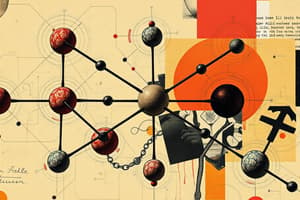Podcast
Questions and Answers
What is the purpose of adding enough electrons to each atom in a Lewis structure?
What is the purpose of adding enough electrons to each atom in a Lewis structure?
To give each atom an octet (except for hydrogen which has two electrons)
How are leftover electrons handled in a Lewis structure?
How are leftover electrons handled in a Lewis structure?
Place them on the central atom
If the central atom in a Lewis structure has fewer electrons than an octet, what should be done?
If the central atom in a Lewis structure has fewer electrons than an octet, what should be done?
Form multiple (double or triple) bonds with terminal atoms to achieve an octet
What is the purpose of the final check in a Lewis structure?
What is the purpose of the final check in a Lewis structure?
Define electron group geometry in the context of VSEPR theory.
Define electron group geometry in the context of VSEPR theory.
What does an electron group in VSEPR theory refer to?
What does an electron group in VSEPR theory refer to?
What is the significance of the VSEPR theory in understanding molecular geometry?
What is the significance of the VSEPR theory in understanding molecular geometry?
How does VSEPR theory account for the shape of a molecule?
How does VSEPR theory account for the shape of a molecule?
Why is achieving an octet important in Lewis structures?
Why is achieving an octet important in Lewis structures?
What is the role of lone pairs in determining molecular geometry?
What is the role of lone pairs in determining molecular geometry?
Flashcards are hidden until you start studying
Study Notes
Molecular Geometry and Electron Group Geometry
- NH3 has 4 electron groups (3 bonded pair groups and 1 lone pair group)
- CO2 has 2 electron groups (two double bonded pair groups)
- Electron groups are negatively charged regions that repel each other
- The repulsive forces between bonding and non-bonding electrons determine the geometry of the groups around a central atom
- Valence Shell Electron Pair Repulsion (VSEPR) Theory predicts the shape of molecules by considering repulsions between pairs of electrons (bonding pairs and lone pairs)
VSEPR Theory
- States that pairs of electrons surrounding a central atom are arranged as far apart as possible to minimize electron-electron repulsion
- The order of repulsion of electron groups is: Lone pair - lone pair > lone pair - bonded pair > bonded pair - bonded pair
Predicting Molecular Geometries
- Steps to predict molecular geometries:
- Sketch the Lewis structure of the molecule or ion
- Count the total number of electron groups around the central atom and work out the electron group geometry
- Arrange the electron groups around the central atom in a way that minimizes repulsions among them
- Identify the type of interactions (Lone pair - lone pair / lone pair - bond pair / bond pair - bond pair) and predict deviations from electron group geometry
- Describe the molecular geometry in terms of the angular arrangement of the bonded atoms
Example: Ammonia (NH3)
- NH3 has a trigonal pyramidal molecular geometry due to its tetrahedral electron group geometry
- The shape of NH3 is predicted by writing the Lewis structure and using the VSEPR theory to determine the electron-group geometry
Electronegativity and Bond Polarity
- Electronegativity affects bond polarity, which measures how equally electrons in a bond are shared between two atoms
- Bond polarity is influenced by the difference in electronegativity between the atoms involved in the bond
Studying That Suits You
Use AI to generate personalized quizzes and flashcards to suit your learning preferences.




